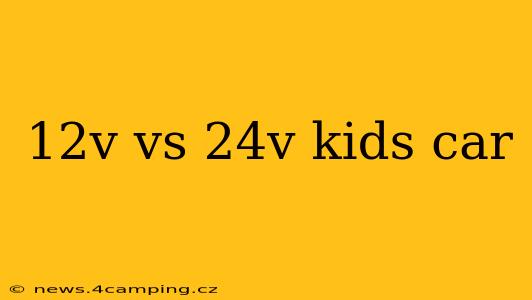Choosing between a 12V and a 24V kids' ride-on car can feel overwhelming. Both offer hours of fun, but the voltage difference significantly impacts performance and suitability for your child. This comprehensive guide will help you navigate the key distinctions and make the best decision for your little one.
What's the Difference Between 12V and 24V?
The core difference lies in the power source: voltage. A 24V battery provides twice the power of a 12V battery. This translates to a noticeable difference in several key aspects of the ride-on car's performance.
Speed and Power: The Most Obvious Difference
This is the most significant difference. 24V ride-on cars are noticeably faster and more powerful than their 12V counterparts. This added power allows them to handle steeper inclines and rougher terrain with greater ease. If your child enjoys a more exhilarating driving experience, a 24V model might be preferable. However, increased speed also means increased safety concerns – more on that later.
Size and Weight Capacity: Considerations for Your Child
While voltage affects power, it doesn't directly correlate with size. You'll find both 12V and 24V cars in various sizes. However, 24V cars often have a higher weight capacity because they're typically designed for older children who are larger and heavier. Always check the manufacturer's specifications regarding weight limits to ensure your child's safety.
What age is a 24V car suitable for?
24V ride-on cars are generally recommended for older children, typically ages 5 and up, due to their higher speed and power. Younger children might find a 12V car more manageable and safer.
Battery Life: A Key Factor to Consider
While a 24V battery delivers more power, it might not necessarily last longer than a 12V battery. The battery life depends on several factors, including the car's features, usage intensity, and battery quality. It's essential to check the manufacturer's specifications for estimated playtime.
How long does a 24V battery last?
The lifespan of a 24V battery varies depending on usage and quality, but typically ranges from several hours to a full day of playtime. Check the specific car's details for accurate information.
Safety Features: A Crucial Aspect of Choosing a Kids' Car
Regardless of voltage, safety should always be the top priority. Look for features like:
- Working seat belts: Essential for securing your child.
- Low speed settings: Crucial for younger children.
- Durable construction: Ensure the car is sturdy and built to withstand bumps and drops.
- Reverse gear: Adds an extra layer of control and safety.
Always supervise your child while they're using the ride-on car, regardless of the voltage.
Price: A Factor to Consider
Generally, 24V ride-on cars are more expensive than 12V models. This is due to their more powerful motors and often more advanced features. However, the increased price might be justified by the longer lifespan and enhanced performance.
Are 24V cars worth the extra cost?
Whether a 24V car is worth the extra cost depends on your budget and your child's needs. If you want a faster, more powerful car for an older child, the investment might be worthwhile. If you're on a tighter budget or have a younger child, a 12V model could be a more suitable and cost-effective option.
Conclusion: Making the Right Choice
Ultimately, the best choice between a 12V and a 24V kids' car depends on your child's age, size, and your budget. Consider the factors discussed above to make an informed decision that prioritizes safety and enjoyment. Remember to always prioritize safety features and supervise your child during playtime.
